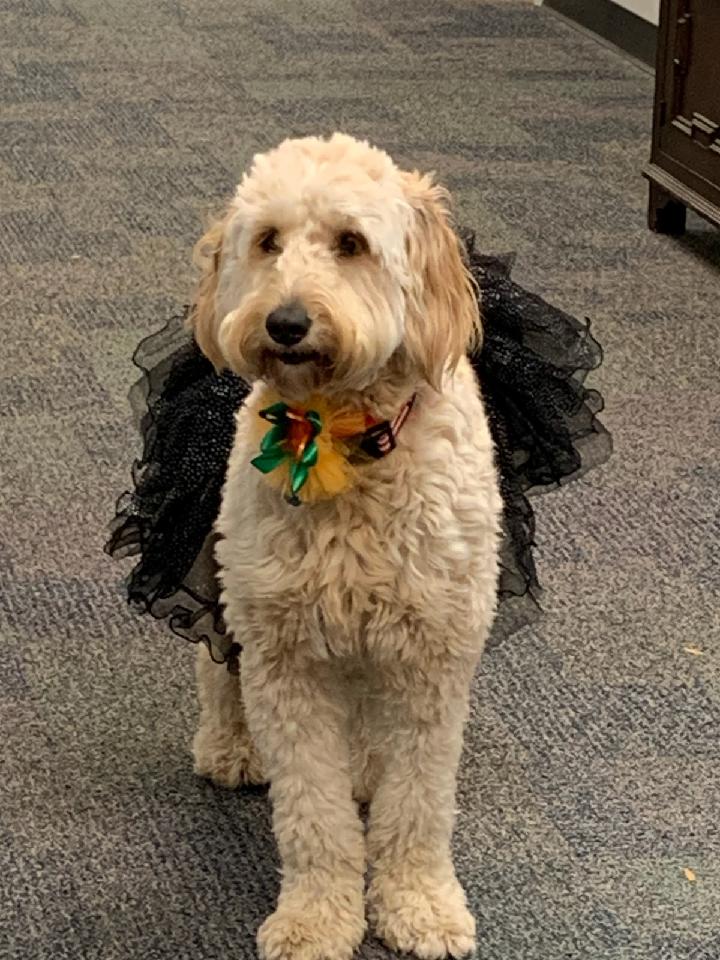Spooky, but Safe!

Lily Spooner, taking a break from her coven duties to see who has treats.
It’s close to midnight, and something evil’s lurking in the…break room?
There’s no time of year quite like Halloween to turn up the fun at work. Carry-ins, costume contests, decorations, and candy can bring even the more introverted employees out of their shells. The same environment can also work Halloween-lovers into a lather with complicated costumes, pranks and jump scares. Believe it or not, Halloween hijinks in the workplace have resulted in quite a few workers’ comp claims. The staff at Spooner loves a good spooky time, so we’ll share some tips that will allow you to keep the festivities going – and keep them safe.
Costumes
There’s always at least one person who’s worked on their costume for weeks and can’t wait to debut it for the contest at work. If you’re planning on allowing employees to wear costumes to work, you may want to lay a few ground rules ahead of time.
- Loose/flowy (dresses, sleeves, capes, etc.) – Anything below ankle length is likely to get stepped on or caught on something, even in an office environment. Long, flowy sleeves or loose fabric is even more dangerous in an industrial setting, where it could get caught in machinery.
- Bulky costumes – Everyone gets a kick out of the T-rex costume until things start getting knocked over. Better to save these costumes for passing out candy or parties outside of the workplace.
- Footwear – Some costumes aren’t complete until you put on the platform shoes or stiletto witch boots that pull the ensemble together. You may be able to navigate just fine in them, but make sure you’re not bending any safety rules with things like open-toes. We’d also recommend doing a “test drive” of the shoes before you commit to them for a whole day of wear, or wear the fun stuff for pics and change into sneakers for the remainder of the workday.
- Common sense – Offer a quick refresher on what is and isn’t allowed per your dress code, and whether or not these rules will apply for Halloween costumes. If leggings and barely-there dresses are a no-go for the rest of the year, make sure staffers know if the rule applies on 10/31.
Décor
Halloween décor can be fun and spooky without being dangerous. There’s a fine line to walk with some of these items - so if it seems dicey, skip it.
- Doorways – Don’t obscure egress points, or make it difficult to get in or out of certain rooms in the building. Avoid going overboard with the spiderwebs and crime scene tape.
- Push pins - Use tape, sticky tack or adhesive hooks to adhere decorations to walls, desks, etc. Push pins and thumb tacks come out more often than they stay put, and they’re also hard to see on any kind of flooring. No great party ever started with a puncture wound.
- Hard to reach spots - Use a ladder (safely!) if hanging decor in higher areas. This may seem like common sense - but if there are still warnings not to drop hair dryers in bathtubs, we’ll keep telling people not to climb surfaces to hang things.
- Pranks – There have been so many stories recently about claims resulting from employees suffering anxiety attacks following work pranks or even surprise parties. Some people detest being pranked and scared so much that they might start swinging, then you have a new problem on your hands. Plus, you never know who has a heart condition. Jump scares aren’t for everyone!
- Chemicals – Very few things convey spooky like dry ice, but it can also cause frostbite, cryogenic burns, respiratory issues and increased heart rate. Fog machines typically use glycol, which can cause irritate eyes, nasal passages and airways.
- Pumpkin carving – This is a number of different accidents waiting to happen: lacerations, puncture wounds, slips, trips and falls. Let people carve at home, and stick to drawing on or painting pumpkins for the work festivities. If jack-o-lanterns can be brought in from home, use flameless tea-lights, not real flame to light them up.
- Food safety – If you’re having a carry-in or allowing people to bring in treats, try sticking with room-temp or pre-packaged items. If things need to be kept hot, plug a slow-cooker into a grounded outlet and set it to warm. If the food needs to be kept cold, keep it refrigerated until it’s time to eat, and don’t let it sit out after lunch. Two hours tops, then it should go back in the fridge.

